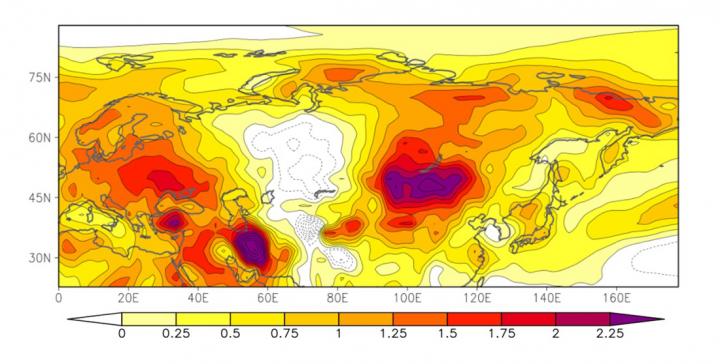Persistent abnormally hot weather can cause negative impacts on human health, agriculture, and natural environments. A heat wave — a spell of hot days with the mercury rising much higher than the average temperature — has been reported more frequently in Europe and Northeast Asia in recent years.
“Internal atmosphere-land interactions in Eurasia are believed to be an important factor in triggering abnormal summer temperatures. However, the exact reasons for such interactions causing heat waves remain largely unclear,” says Associate Professor Tomonori Sato of the research team.
In the present study published in
Scientific Reports
, Tomonori Sato and Tetsu Nakamura of Hokkaido University examined a large dataset derived from the “database for Policy Decision making for Future climate change” (d4PDF). The database comprises data spanning over a 60-year period (1951-2010) which incorporates observed sea surface temperature, sea ice, and natural and anthropogenic forcing.
The researchers analyzed 6,000 patterns in the spatial distribution of summer temperatures in Eurasia, and succeeded in dividing past summer temperature variations into two groups–one attributable to global warming and the other attributable to natural changes. The former exhibited the rising temperatures in Eurasia since around 1990, while the latter showed the spatial distribution of low and high temperatures that correspond to the meandering of the westerlies. The distribution shows a wave train-like structure – which demonstrates that when some regions experienced abnormally high temperatures, the surrounding areas were hit by abnormally low temperatures.
The researchers then discovered that when Western Russia had a deeper-than-usual snow cover in late winter and spring, the wave train-like distribution of temperatures appeared. When deeper snow accumulation occurs, more moisture retains in the soil after snowmelt. The soil moisture then prevents the summer temperature from rising, which is a likely cause for making the westerlies meander, thus causing the surrounding regions to experience high temperatures.
###
This part of information is sourced from https://www.eurekalert.org/pub_releases/2019-08/hu-dsc083019.php
Naoki Namba
81-117-062-185
[email protected]
https://www.global.hokudai.ac.jp/


